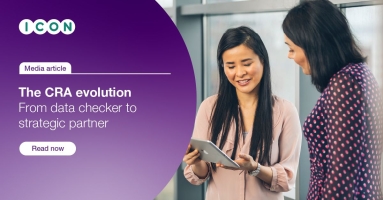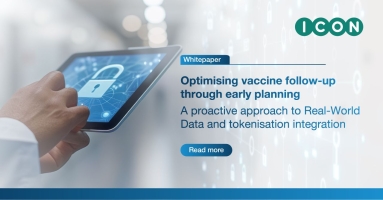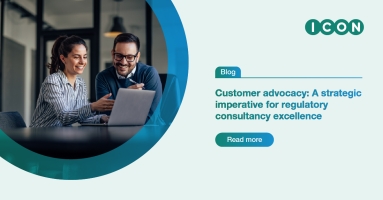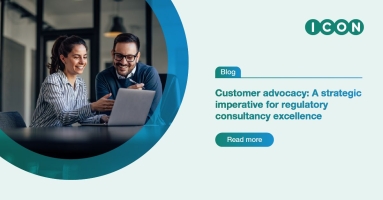Attending #ASH25? Stop by booth \#2161 to meet the ICON team and discuss how our extensive testing capabilities, clinical research experience and scientific expertise can support global oncology and haematology research ...
Patient Centricity
Insights on patient-centric approaches to enhance patient engagement, safety and inclusion
Accelerating clinical development through digital health technologies
This whitepaper presents a comprehensive roadmap for adopting DHTs in clinical trials, from selecting the right digital measures to implementing them at scale. Read this whitepaper to learn the DHT strategies that reduce trial costs, accelerate timelines, and help bring patient-centred treatments to market.

Outcome measures: Prioritising patient-centred research for regulatory approval
This whitepaper presents a framework for designing more efficient trials by starting with patient priorities and combining multiple measurement approaches (COAs and DHTs) to demonstrate treatment efficacy and provide meaningful patient benefits.

Ensuring the validity of clinical outcomes assessment data: The value of rater training
The necessity of appropriately training raters for reducing variability in measurements, rater interpretation, and bias and scale administration errors in COA implementation are outlined in this whitepaper.

Using longitudinal qualitative research to capture the patient voice
In this whitepaper we introduce the basic principles of sound longitudinal qualitative research and offer advice for sponsors considering such an approach as a way of insuring that their development efforts are patient centric.

Inclusion in clinical trials
Paving the way for representative inclusion in clinical trials: establishing a platform for improvement
This whitepaper examines the barriers to accessing under-represented subgroups, the regulatory landscape and how organisations are addressing this issue.

Patient centricity in orphan drug development
Currently, 6,000 to 8,000 rare diseases have been identified worldwide, and an estimated 250 to 280 new ones are discovered annually. ICON analysed data on the use of patient-reported outcomes measures (PROMs) in orphan drug labeling claims and performed an extensive literature review on the use of PROMs in all phases of clinical research.

Capturing the voice of the patient in clinical trials
There is no substitute for speaking directly with patients. Regulatory agencies, HTAs and researchers agree and are encouraging qualitative research to enrich quantitative data in RCTs. Read our whitepaper for insights on effectively integrating qualitative interviews into your protocol.

Will US payers give more consideration to PRO data in coverage decisions?
In the US, payers have historically focused on efficacy and safety endpoints as well as cost, with very little attention given to patient reported outcomes (PROs). With the increase in patient centricity, we surveyed US payers to learn if they were changing their approach.

Exploring the patient dynamic from different perspectives
In early 2020, ICON invited distinguished speakers - a patient advocate, a clinical investigator and a pharmaceutical executive - to participate in a panel discussion, chaired by ICON's Dr. Nuala Murphy. The panellists discussed the dynamics of patient centricity in clinical research from their various stakeholder positions. This report is a summary of their lively and informative discussion.

Patient voice survey - decentralised and hybrid trials
ICON conducted a survey through its Global Site Network to get the patient view on decentralised trials and find out whether bringing the trial to the patient could really make a difference in accessing more patients. We explored perceptions and preferences around what makes it easier for patients to participate in clinical trials and to determine whether industry perception of patient burden was the reality.

Reimagining patient-centricity with the Internet of Medical Things (IoMT)
In this whitepaper, we follow a theoretical patient through the entire clinical trial journey – from initial contact for an early study through transition to treatment with an approved product. At each stage, we explore how IoMT can increase clinical development programme efficiency by reducing the burden on patients, caregivers, pharma companies and medical device and diagnostic manufacturers.

Charting the managed access program (MAP) landscape
Many patients with serious diseases cannot wait for an investigational product to move from the lab to the pharmacy shelf. Managed Access Programs are one solution for early access to investigational products. Read our whitepaper to prepare for the clinical and operational complexities.

Nurse-centric medical communication
While pharma has historically focused their medical communications strategies and scientific data dissemination plans to physicians and payers, they have done little to explore the needs of nurses, who also play a central role in patient care. We surveyed 100+ oncology nurses to understand their medical communication needs and preferences and to identify any gaps.
Read our whitepaper for insights on how to design and execute a medical communications program that speaks directly to nurses for greater patient access and engagement across therapeutic areas.

Patient outcomes
ICON is working with the International Consortium for Health Outcomes Measurement (ICHOM) to develop The Global Outcomes Benchmarking (GLOBE) program. Rather than focusing on clinical indicators, ICHOM shifts the focus to outcomes that patients care about, including functional improvements and the capacity to live productive lives.
ICON Insights: mHealth devices allow for better treatments and clinical outcomes - Continuous monitoring of patients enables continuous treatment adjustments and alerts clinicians when emergencies arise - resulting in better, more personalised treatment and improved clinical outcomes, with fewer clinic visits and greater independence for patients.
The long journey towards patient centricity - A look at the regulatory efforts implemented in the last 30 years to include the patients’ perspective into drug development.

Patient monitoring
Patient Centric Monitoring whitepaper
Patient Centric Monitoring is ICON’s methodology for the design and execution of an adaptive risk based monitoring strategy guided by risk assessment using ICONIK analysis. Risk based monitoring in clinical trials is a monitoring approach where activities, resources and technologies are adapted to the risks in the study. Patient Centric Monitoring further focuses on the probability of errors that matter in decision making for patients.

The patient-consumer
Today, fewer and fewer patients passively accept physicians’ advice. Patients are increasingly active, informed consumers entering clinics armed with research and opinions about their healthcare options. They desire data on similar patients while calculating the benefits and risks of their choices. To the patient–consumer, "precision medicine" represents the ideal standard of care: the individualised, evidence-based treatment that provides the best opportunity for a positive outcome. Read our three-part series exploring the patient-consumer:
Part One: From biomarkers to biosensors
Part Two: Beyond biomarker-based patient stratification
Part Three: Applications for wearables and apps in precision medicine
Latest on Patient Centricity
If you would like to receive our Patient Centricity email updates, including the latest on companion diagnostics, drug safety, optimising late phase studies, as well as patient reported outcomes and site and patient recruitment, visit our preference centre.
Accelerating patient access
Launching a patient registry: seven factors for success
Registries are economical and flexible, and ideal for collecting data from a wide range of patients and sites, generating the real world evidence regulators and payers require to demonstrate effectiveness and safety, and to support label and coverage extensions. But this flexibility also creates risk. To generate useable, uniform data, registries must be carefully designed and administered. Consider these seven factors as you design and launch a successful registry.














